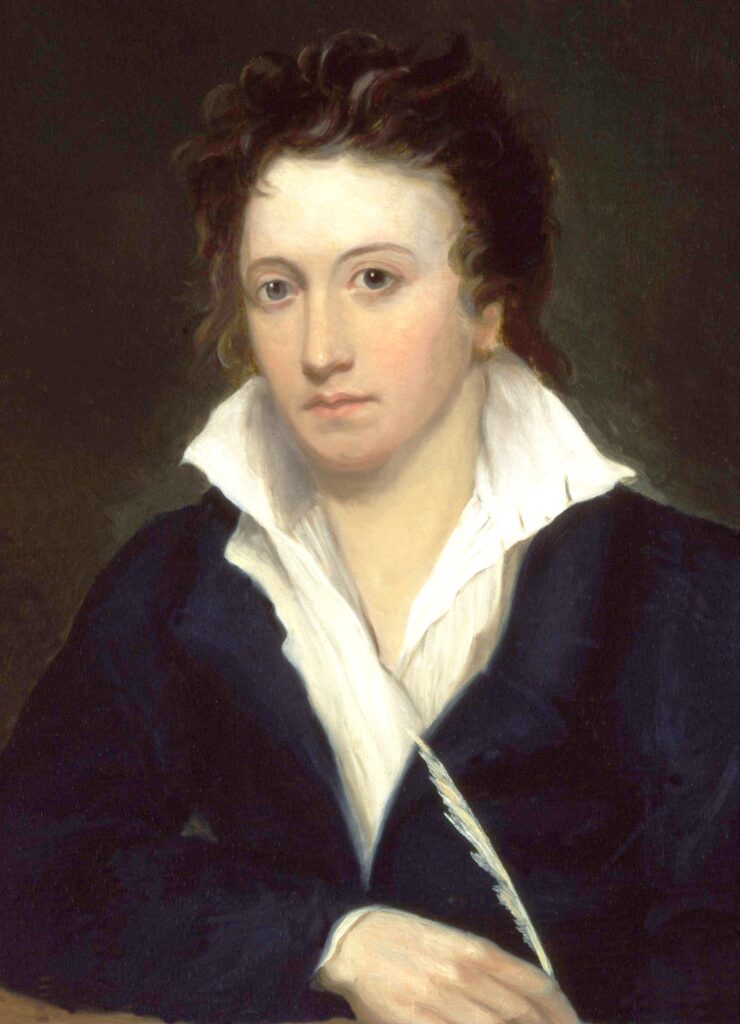
When Percy Bysshe Shelley drowned off the north-west coast of Italy in July 1822, just a month short of his thirtieth birthday, he left behind a quantity of poetry and prose across the entire spectrum of genres : from dream vision and epic-romance, tragic and comic verse drama, political ballad, satirical squib, popular song, funeral elegy, allegory, confessional autobiography, ode and hymn – as well as the exquisitely crafted brief lyrics for which he is mostly remembered.

Shelley’s extraordinary output has come to be recognised as one of the major literary contributions to the English Romantic Movement.
His poetry in particular as boldly original, technically accomplished and critically challenging.
Shelley’s magnificent “ Ode to the West Wind ,” demands to be read on several levels and I realised this later in life when I read it once again, not as a student but as an adult.
In this poem, the wind and the surrounding natural environment are thought of as linked to the poet’s inner being, and thus the wind becomes a source of spiritual and poetic vitality.
Shelley’s “Ode to the West Wind ” is an address to a powerful though invisible agent, and a wish for the blessing of poetic inspiration.
Wild Spirit, which art moving everywhere;
Ode to the West Wind
Destroyer and preserver; hear, oh hear!
The poem strangely blends hope and despair. The poet falls upon the thorns of life, and he prays to the wind to lift him as a leaf, a wave, a cloud, as anything but a human being.
Drive my dead thoughts over the universe
Like wither’d leaves to quicken a new birth!
And, by the incantation of this verse,Scatter, as from an unextinguish’d hearth
Ashes and sparks, my words among mankind!
Be through my lips to unawaken’d earthThe trumpet of a prophecy! O Wind,
Ode to the West Wind
If Winter comes, can Spring be far behind?
Written in the early summer of 1822, Shelley left “The Triumph of Life ” unfinished when he died on July 8, 1822, when his boat Don Juan capsized. Indeed, Shelley had written part of the poem while sailing in this very same boat.
Although “The Triumph of Life” ends on a note of fatalism regarding the human condition, it still offers the chance to recoup a type of spirituality by remaining faithful to one’s hopes and aspirations.
Despite the fact that there is pain and suffering, one needs to be fully responsive to all life’s circumstances.
Though referring specifically to Dante, Rousseau’s message is universal.
“Of him whom from the lowest depths of Hell
The Triumph of Life
Through every Paradise & through all glory
Love led serene, & who returned to tell
“In words of hate & awe the wondrous story
How all things are transfigured, except Love;
Did you Know?

- Percy Bysshe Shelley, the radical nonconformist, was born in 1792 to a conservative aristocratic family.
- Shelley’s first poetic work, Queen Mab, was printed privately.
- In 1813 Shelley fell in love with Godwin’s daughter, the beautiful Mary Wollstonecraft (who would one day write the popular Gothic novel Frankenstein ). At the time, Shelley was still married to Harriet Westbrook, a woman with whom he had eloped with in 1811 when she was only sixteen years old.
- Like his friend William Godwin, Shelley was opposed to the institution of marriage as yet another form of tyranny and codified degradation, but despite this philosophy, he entered his second marriage to Mary Wollstonecraft in 1818.
- Shelley became a social outcast with a reputation for being both an atheist and an immoralist. He had children with both his wives, but he was denied custody of the two children from his marriage with Harriet. Feeling rejected by society, Shelley moved to Italy and continued his restless existence there, wandering from place to place .
- Shelley’s time at Eton was not entirely happy. Slight of build and unskilled in sports, Shelley was often the target of older and stronger boys.Shelley recorded recollections of these schoolboy days in the dedication to Laon and Cythna (later called The Revolt of Islam): “So without shame, I spake:— ‘I will be wise, / And just, and free, and mild’ . . . I then controlled / My tears, my heart grew calm, and I was meek and bold.”
- Shelley was expelled from Oxford in 1811. He collaborated on a pamphlet, The Necessity of Atheism, which claimed that God’s existence could not be proven on empirical grounds (by mere observation or experience) and further, that “no degree of criminality is attachable to disbelief.” Needless to say, this pamphlet created shock waves and the university demanded a retraction of the ideas it promulgated.
- On a trip to Geneva , Shelley first met Byron in May 1816. Byron was 28 at the time and Shelley was now 23; both bore the unpleasant memory of failed marriages and a grievance against aristocratic pretence.
Conclusion
Shelley wrote some of his greatest poetry and prose, including his masterpiece, Prometheus Unbound, a play that dramatizes the suffering of Prometheus, the ancient Greek god who was punished for stealing fire from heaven in order to give it to mankind. He also wrote “Adonais,” a brilliant elegy on the death of his beloved poet, John Keats, and a very important critical work, A Defence of Poetry.
His death, ironically, left unfinished what promised to be his greatest achievement, “The Triumph of Life.”
Disclaimer: All recommendations are impartial and based on user experience, with no bias to the products or the brand. The products in this post may contain affiliate links.
[…] The Triumph of Life: Percy Bysshe Shelley […]